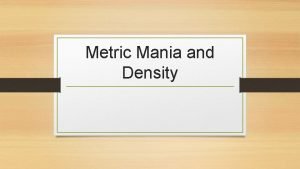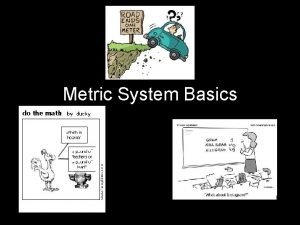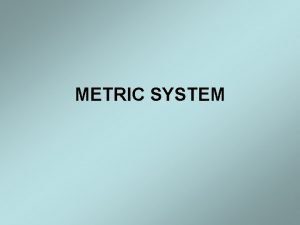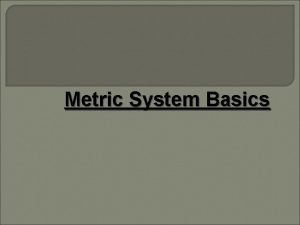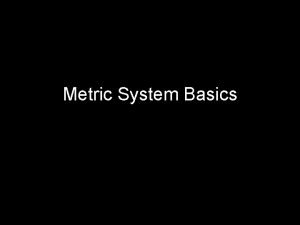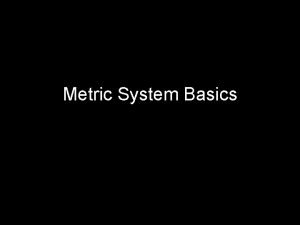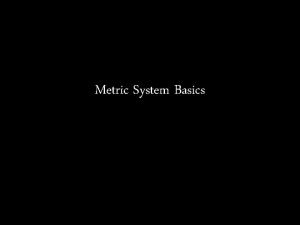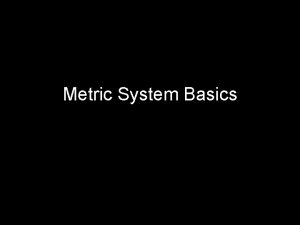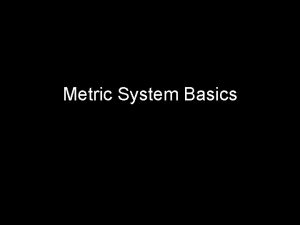Metric System or SI System The metric system










- Slides: 10

Metric System or SI System The metric system is: • Used throughout most of the world and universally used in science. • Based on units of 10 o To convert from one unit to another you either multiply or divide by 10 or multiples of 10 (simply move the decimal point left or right the appropriate number or spaces)

I. Measuring length in SI Units: Length – Distance from one point to another The basic unit of length in the metric system is the meter ( m ). The different units in the metric system for length and all other measurements are named by putting different prefixes in front of the basic unit. Ex. Kilometer - Prefix = kilo which means 1000 Basic unit = meter

Common Prefixes Prefix Mega. Kilo- Meaning 1, 000 Hecto- 100 Deka- 10 Basic unit 1 Example (length) Megameter (Mm) Kilometer (km) 1000 meters Hectometer (hm) Dekameter (dam) Meter (m) Deci- 0. 1 Centi- 0. 01 Centimeter (cm) Milli- 0. 001 0. 000001 Millimeter (mm) Micro- Decimeter (dm) Micrometer (um)

To convert a measurement from one unit to another you move the decimal point to the left or right the appropriate number of spaces. Rule 1 – If you are going from a large unit to a small unit, move the decimal point to the right Rule 2 – If you are going from a small unit to a large unit, move the decimal point to the left

3 spaces d c micro b milli da centi deci h Basic k deka kilo M hecto Mega Rule 3 – To determine how many decimal places you move the decimal point use the following diagram: m u 3 spaces Remember: Mighty King Harry Died By Drinking Chocolate Milk Unfortunately

II. Measuring Volume in SI Units: Volume – amount of space occupied by an object The basic unit of volume in the metric system is the liter ( L ) To read the volume in a graduated cylinder, read from the bottom of the meniscus Examples of units for volume: kiloliter (k. L), milliliter (m. L) Conversions for volume you should know: 1 liter = 1000 ml 1 kiloliter = 1000 L = 1, 000 ml

III. Measuring Mass in SI Units: Mass – amount of matter in an object The basic unit of mass in the metric system is the gram ( g ) Examples of units for mass: centigram (cg), microgram (ug) Conversions for mass you should know: 1 gram = 1000 mg 1 kilogram = 1000 g = 1, 000 mg

IV. Measuring Temperature in SI Units: The basic unit of temperature in the metric system is degrees Celsius The Celsius scale is based on the freezing point 0 o and boiling point 100 o of water. Normal body temperature = 37 o. C Room temperature = 25 o. C

Practice Problems: 1. 9000 cm = 90 m 2. 4700 mm = 4700000 um 3. 170 g =. 170 kg 4. 122 micrometers =. 122 mm 5. 878 d. L = 87800 m. L 6. 4. 7 m = 470 cm 7. 23. 4 m =. 0234 km

1. 8. How many L in 150 ml? . 150 2. 9. How many mm in 2 meters? 2000 3. 10. How many cm in 550 mm? 55 4. 11. What volume is located in the graduated cylinder below? 13 ml
